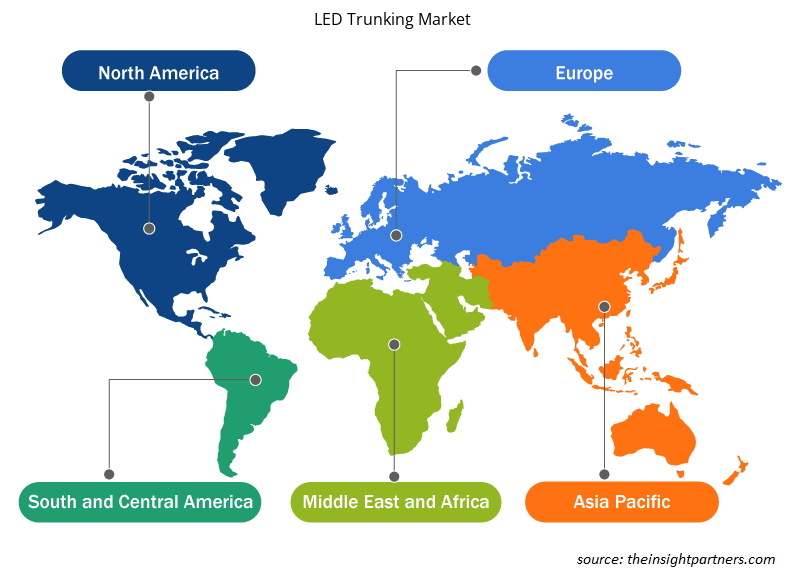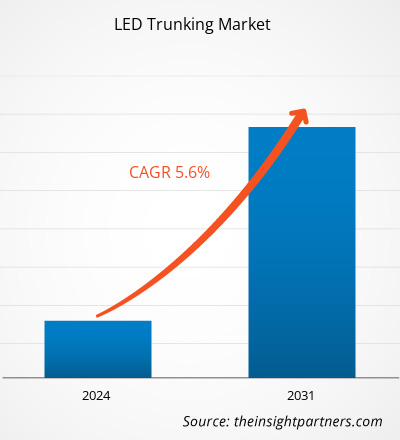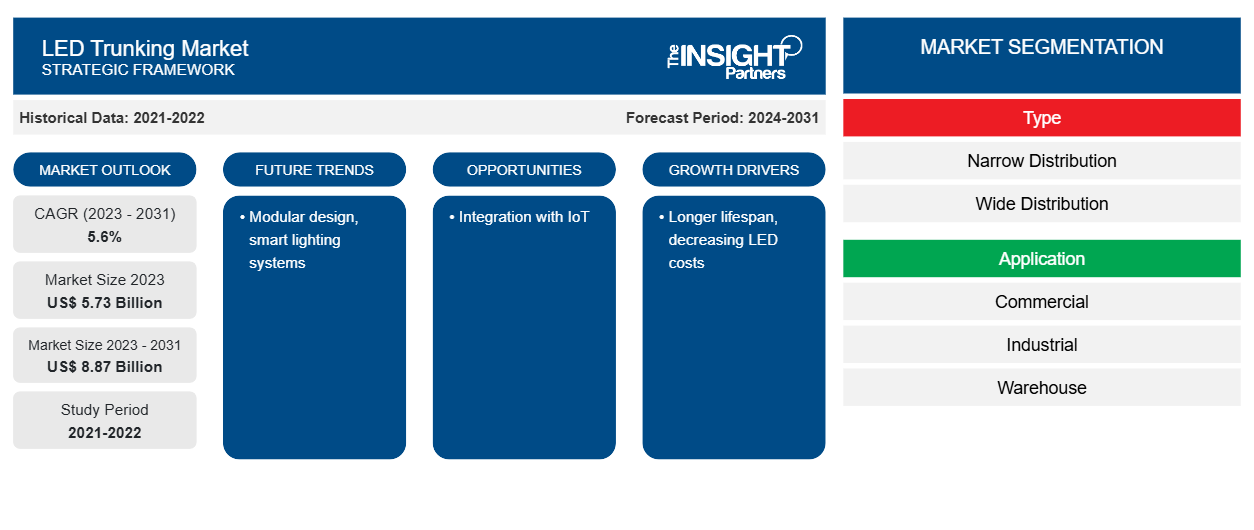Der Markt für LED-Lichtleisten soll von 5,73 Milliarden US-Dollar im Jahr 2023 auf 8,87 Milliarden US-Dollar im Jahr 2031 anwachsen. Der Markt wird voraussichtlich zwischen 2023 und 2031 eine durchschnittliche jährliche Wachstumsrate von 5,6 % verzeichnen. Modulares Design und intelligente Beleuchtung bleiben voraussichtlich die wichtigsten Trends auf dem Markt für LED-Lichtleisten.
LED-Lichtleisten Marktanalyse
LED-Lichtbandsysteme sind durchgehende Lichtbandsysteme, die über Lichtbandschienen einzelne Beleuchtungskörper/Unterbaugruppen wie LED-Lichtmodule, Netzteile, Lichtsteuerungen, Notbatterien und/oder andere Funktionen verbinden. Flexible Lichtbandsysteme können auf verschiedene Arten gebaut werden, um die hohen Anforderungen an die Innenbeleuchtung in Gewerbe- und Industriegebäuden zu erfüllen.
Marktübersicht für LED-Lichtleisten
Viele Gewerbegebäude und Industrieanlagen sind groß und verfügen über eine komplexe Infrastruktur, die eine sorgfältige Systemintegration und -planung erfordert. Bei der Lichtgestaltung dieser Orte geht es um mehr als nur die Einhaltung von Qualitäts-, Quantitäts- und Betriebsstandards. Bei der Innenausstattung großer Gewerbegebäude wie Supermärkten, Hypermärkten, Kaufhäusern, Lagerhallen, Vertriebszentren, Handelszentren, Ausstellungshallen, Bürogebäuden usw. geht es eher um die Vernetzungs- und Steuerungsmöglichkeiten von Beleuchtungsgeräten sowie um die Gesamtlebenszykluskosten der Beleuchtung. Dies treibt die Nachfrage nach LED-Lichtbandprodukten auf dem Markt an.
Passen Sie diesen Bericht Ihren Anforderungen an
Sie erhalten kostenlos individuelle Anpassungen an jedem Bericht, einschließlich Teilen dieses Berichts oder einer Analyse auf Länderebene, eines Excel-Datenpakets sowie tolle Angebote und Rabatte für Start-ups und Universitäten.
-
Holen Sie sich die wichtigsten Markttrends aus diesem Bericht.Dieses KOSTENLOSE Beispiel umfasst eine Datenanalyse von Markttrends bis hin zu Schätzungen und Prognosen.
Treiber und Chancen auf dem LED-Kabelkanalmarkt
Energieeffizienz begünstigt den Markt
LED-Lichtbandsysteme sind eine energieeffiziente, leistungsstarke und wartungsarme Alternative zu herkömmlichen linearen Leuchtstofflampensystemen und eignen sich ideal für Anwendungen in offenen Räumen und niedrigen Räumen. Die LED-Beleuchtungstechnologie überwindet viele der Nachteile von Leuchtstofflampen, indem sie die Energieumwandlungseffizienz erheblich verbessert, eine gute Steuerbarkeit, hohe Haltbarkeit und Zuverlässigkeit, längere Lebensdauer, sofortiges Einschalten/schnelles Ein- und Ausschalten und kompakte Formfaktoren bietet. Zu den Vorteilen von LED-Lichtbandsystemen gehören ihre unglaubliche Designflexibilität, unübertroffene Leistung, einfache Installation und hochentwickelte digitale Steuerung, die neue Horizonte für innovative kommerzielle Beleuchtungskonzepte eröffnen, die mit herkömmlichen Beleuchtungstechnologien oder anderen LED-Beleuchtungssystemen nicht möglich sind.
Integration mit IoT – eine Chance auf dem LED-Lichtbandmarkt
Das LED-Lichtbandsystem kann mit Sensoren erweitert werden, die die Integration von Einzelhandels- und Lagertechnologie wie Kameras, Beacons, Audio und Scanner in ein einziges System ermöglichen. Im Jahr 2017 stellte Philips Lighting heute seine neue LED-Lichtbandlösung für Einzelhandels- und Industrieumgebungen vor, Philips Maxos Fusion. Dieses vernetzungsfähige System hilft dabei, Gebäude zukunftssicher zu machen, indem es hochwertige LED-Beleuchtung mit der Möglichkeit kombiniert, Lichteffekte zu ändern und das System mit anderen Technologien des Internets der Dinge zu skalieren. Der Auchan Hypermarket in Saint-Priest, Frankreich, war der erste, der Philips Maxos Fusion installierte und von der Möglichkeit profitierte, sein Ladenlayout mit einem konfigurierbaren Lichtdesign zu ergänzen, das zukünftige Alternativen bietet.
Segmentierungsanalyse des LED-Trunking-Marktberichts
Wichtige Segmente, die zur Ableitung der Marktanalyse für LED-Kabelkanäle beigetragen haben, sind Typ und Anwendung.
- Basierend auf dem Typ ist der Markt für LED-Trunking in schmale und breite Verteilung unterteilt. Das Segment der breiten Verteilung hatte im Jahr 2023 den größten Marktanteil.
- Basierend auf der Anwendung wird der Markt für LED-Kabelkanäle in gewerblich, industriell, Lagerhallen und Sonstiges unterteilt.
LED-Lichtleisten Marktanteilsanalyse nach Geografie
Der geografische Umfang des Berichts zum Markt für LED-Kabelkanäle ist hauptsächlich in fünf Regionen unterteilt: Nordamerika, Asien-Pazifik, Europa, Naher Osten und Afrika sowie Südamerika/Süd- und Mittelamerika.
Der asiatisch-pazifische Raum dominierte dieMarkt für LED-Lichtleisten. Die Region hat im letzten Jahrzehnt eine rasante Urbanisierung und Industrialisierung erlebt, was den Bedarf an energieeffizienten Beleuchtungslösungen zur Unterstützung einer nachhaltigen Infrastruktur erhöht. Darüber hinaus treiben staatliche Vorschriften und Initiativen zur Förderung energieeffizienter Beleuchtung in industriellen und gewerblichen Umgebungen das Wachstum des Marktes weiter voran.
Regionale Einblicke in den LED-Lichtbandmarkt
Die regionalen Trends und Faktoren, die den LED-Trunking-Markt während des Prognosezeitraums beeinflussen, wurden von den Analysten von Insight Partners ausführlich erläutert. In diesem Abschnitt werden auch die Marktsegmente und die Geografie von LED-Trunking in Nordamerika, Europa, im asiatisch-pazifischen Raum, im Nahen Osten und Afrika sowie in Süd- und Mittelamerika erörtert.

- Erhalten Sie regionale Daten zum LED-Kabelkanalmarkt
Umfang des Marktberichts zu LED-Kabelkanälen
| Berichtsattribut | Details |
|---|---|
| Marktgröße im Jahr 2023 | 5,73 Milliarden US-Dollar |
| Marktgröße bis 2031 | 8,87 Milliarden US-Dollar |
| Globale CAGR (2023 - 2031) | 5,6 % |
| Historische Daten | 2021-2022 |
| Prognosezeitraum | 2024–2031 |
| Abgedeckte Segmente |
Nach Typ
|
| Abgedeckte Regionen und Länder |
Nordamerika
|
| Marktführer und wichtige Unternehmensprofile |
|
Dichte der Marktteilnehmer für LED-Kabelkanäle: Auswirkungen auf die Geschäftsdynamik verstehen
Der Markt für LED-Kabelkanäle wächst rasant, angetrieben durch die steigende Nachfrage der Endnutzer aufgrund von Faktoren wie sich entwickelnden Verbraucherpräferenzen, technologischen Fortschritten und einem größeren Bewusstsein für die Vorteile des Produkts. Mit steigender Nachfrage erweitern Unternehmen ihr Angebot, entwickeln Innovationen, um die Bedürfnisse der Verbraucher zu erfüllen, und nutzen neue Trends, was das Marktwachstum weiter ankurbelt.
Die Marktteilnehmerdichte bezieht sich auf die Verteilung der Firmen oder Unternehmen, die in einem bestimmten Markt oder einer bestimmten Branche tätig sind. Sie gibt an, wie viele Wettbewerber (Marktteilnehmer) in einem bestimmten Marktraum im Verhältnis zu seiner Größe oder seinem gesamten Marktwert präsent sind.
Die wichtigsten auf dem LED-Kabelkanalmarkt tätigen Unternehmen sind:
- LEDYi-Beleuchtung
- Dioden
- GE-Beleuchtung
- ED Linear
- SIRS-E LED
- NVC LED-Streifen
Haftungsausschluss : Die oben aufgeführten Unternehmen sind nicht in einer bestimmten Reihenfolge aufgeführt.

- Überblick über die wichtigsten Akteure auf dem LED-Kabelkanalmarkt
Neuigkeiten und aktuelle Entwicklungen zum LED-Kabelkanalmarkt
Der LED-Trunking-Markt wird durch die Erfassung qualitativer und quantitativer Daten nach Primär- und Sekundärforschung bewertet, die wichtige Unternehmensveröffentlichungen, Verbandsdaten und Datenbanken umfasst. Im Folgenden finden Sie eine Liste der Entwicklungen auf dem Markt für LED-Trunking-Markt und Strategien:
- Osram hat einen neuen industriellen LED-Treiber entwickelt. Der neue 300-Watt-LED-Treiber von OSRAM erweitert das Leistungsspektrum der OTi DALI-Produktlinie. Er ist eine hervorragende Lösung sowohl für lineare Industriebeleuchtung, wie z. B. Lichtbandsysteme, als auch für Hallenleuchten. (Quelle: Osram, Pressemitteilung, 2021)
Marktbericht zu LED-Kabelkanälen – Abdeckung und Ergebnisse
Der Bericht „Marktgröße und Prognose für LED-Trunking (2021–2031)“ bietet eine detaillierte Analyse des Marktes, die die folgenden Bereiche abdeckt:
- Marktgröße und Prognose auf globaler, regionaler und Länderebene für alle wichtigen Marktsegmente, die im Rahmen des Projekts abgedeckt sind
- Marktdynamik wie Treiber, Beschränkungen und wichtige Chancen
- Wichtige Zukunftstrends
- Detaillierte PEST/Porters Five Forces- und SWOT-Analyse
- Globale und regionale Marktanalyse mit wichtigen Markttrends, wichtigen Akteuren, Vorschriften und aktuellen Marktentwicklungen
- Branchenlandschaft und Wettbewerbsanalyse, einschließlich Marktkonzentration, Heatmap-Analyse, prominenten Akteuren und aktuellen Entwicklungen
- Detaillierte Firmenprofile
- Historische Analyse (2 Jahre), Basisjahr, Prognose (7 Jahre) mit CAGR
- PEST- und SWOT-Analyse
- Marktgröße Wert/Volumen – Global, Regional, Land
- Branchen- und Wettbewerbslandschaft
- Excel-Datensatz
Aktuelle Berichte
Erfahrungsberichte
Grund zum Kauf
- Fundierte Entscheidungsfindung
- Marktdynamik verstehen
- Wettbewerbsanalyse
- Kundeneinblicke
- Marktprognosen
- Risikominimierung
- Strategische Planung
- Investitionsbegründung
- Identifizierung neuer Märkte
- Verbesserung von Marketingstrategien
- Steigerung der Betriebseffizienz
- Anpassung an regulatorische Trends























 Kostenlose Probe anfordern für - Markt für LED-Trunking
Kostenlose Probe anfordern für - Markt für LED-Trunking